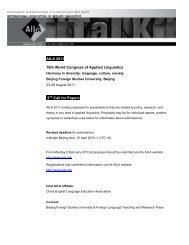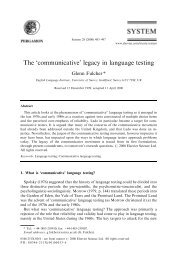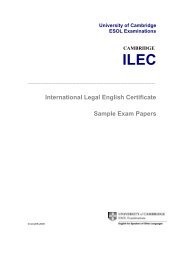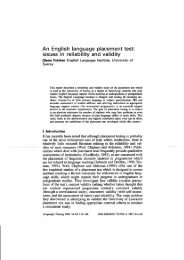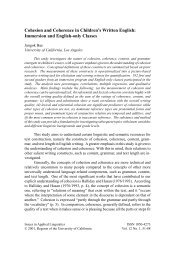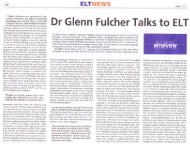Liaison Magazine - LLAS Centre for Languages, Linguistics and ...
Liaison Magazine - LLAS Centre for Languages, Linguistics and ...
Liaison Magazine - LLAS Centre for Languages, Linguistics and ...
Create successful ePaper yourself
Turn your PDF publications into a flip-book with our unique Google optimized e-Paper software.
teaching<br />
Teaching visual arts in modern languages<br />
Good examples of content innovation in languages degree programmes can be found<br />
across the UK. Here, Matthew Treherne outlines the rationale <strong>for</strong> introducing visual arts<br />
into the curriculum, <strong>and</strong> discusses the associated challenges <strong>and</strong> positive outcomes.<br />
University teachers should<br />
always be careful not to<br />
assume that their own<br />
experience as students is normative. But<br />
my own first steps in the study of art,<br />
over the course of my modern<br />
languages degree, have in many ways<br />
shaped my commitment to teaching<br />
visual topics. I first became interested in<br />
art on my year abroad: living in Rome, I<br />
knew there was a whole cultural world<br />
in the galleries <strong>and</strong> churches of the city,<br />
<strong>and</strong> – without underst<strong>and</strong>ing much of<br />
what I was seeing – I set about<br />
discovering as much of it as I could.<br />
Returning to the final year of my<br />
languages degree, <strong>and</strong> with guidance<br />
from my tutors, I started seeing ways in<br />
which even a little knowledge of art<br />
could enrich the subjects I was studying.<br />
Futurist theory looked a whole lot more<br />
interesting when I thought about it<br />
alongside Futurist painting; it seemed to<br />
make sense to think about Renaissance<br />
poetry alongside the art which helped<br />
shape the imagination of readers <strong>and</strong><br />
writers. A range of exciting possibilities<br />
suddenly opened up.<br />
What I had glimpsed as a student was<br />
what I now see as the intellectual <strong>and</strong><br />
pedagogical rationale <strong>for</strong> teaching visual<br />
arts in modern languages.The<br />
relationship between literary <strong>and</strong> visual<br />
culture has been a vibrant research area<br />
<strong>for</strong> some years now: from the use of<br />
ekphrasis in medieval <strong>and</strong> Renaissance<br />
poetry, to the twentieth-century livre<br />
d’artiste, the visual <strong>and</strong> the literary have<br />
been examined together in often highly<br />
illuminating scholarship. By introducing<br />
art to students, we lead them into this<br />
exciting area of research. And<br />
academics’ research can benefit too: the<br />
Subject <strong>Centre</strong> recently identified<br />
disciplinary undergraduate teaching as a<br />
barrier to interdisciplinary research;<br />
teaching across the visual-literary<br />
disciplinary divide is one way to begin to<br />
address this problem (<strong>LLAS</strong> Subject<br />
<strong>Centre</strong> 2007: 37).<br />
There are excellent pedagogical<br />
reasons <strong>for</strong> teaching visual arts in<br />
modern languages programmes. Perhaps<br />
most obviously, the year abroad provides<br />
great opportunities to discover art: many<br />
students will spend, as I did, their year<br />
abroad in cities full of art or will at least<br />
have the chance to visit those cities.<br />
Encouraging students to discover these<br />
artworks is an excellent way to enrich<br />
their engagement with the culture in<br />
which they are living.<br />
It is perhaps unsurprising, then, that<br />
visual arts topics appear to be<br />
increasingly popular in departments of<br />
modern languages.Yet the integration of<br />
visual arts into modern languages syllabi<br />
is in many ways uncharted territory. It is<br />
<strong>for</strong> this reason that my colleagues<br />
Emma Wagstaff (Department of French,<br />
University of Birmingham), <strong>and</strong> Abigail<br />
Brundin (Department of Italian,<br />
University of Cambridge) <strong>and</strong> I coorganised<br />
a workshop on this subject,<br />
which was held in Cambridge in<br />
November 2007, <strong>and</strong> attended by<br />
thirty colleagues.<br />
The workshop participants were all<br />
concerned with the same fundamental<br />
questions. How do we encourage<br />
students with little experience of<br />
studying art to engage effectively with<br />
visual topics How can we integrate<br />
study of the visual arts into modern<br />
languages programmes, rather than treat<br />
them as an add-on, interesting but<br />
fundamentally separate from the rest of<br />
the curriculum Can we do anything<br />
distinctive when we teach art in modern<br />
languages programmes, or are we just<br />
offering a watered-down version of<br />
what is taught in Art History<br />
departments<br />
What emerged in the workshop was<br />
a strong sense of the potential value of<br />
teaching visual arts in modern languages<br />
programmes. As many participants<br />
pointed out, modern languages courses<br />
offer students the opportunity to study<br />
visual arts in their broad cultural <strong>and</strong><br />
social contexts. Students have the skills<br />
to examine relevant <strong>for</strong>eign language<br />
texts alongside visual arts, something<br />
which cannot always be taken <strong>for</strong><br />
granted in Art History departments.<br />
Across institutions, different ways were<br />
being found to link visual <strong>and</strong> literary<br />
studies: illustrations <strong>and</strong> texts were being<br />
examined together; theoretical concepts<br />
in visual representation were linked to<br />
theoretical questions in literary criticism;<br />
works of art theory were being studied<br />
alongside the art works themselves. It<br />
was clear that colleagues were using<br />
visual topics to stretch students in new<br />
directions, whilst developing their<br />
existing skills.<br />
Inevitably, there is a downside to all of<br />
this. Some participants expressed regret<br />
that there simply was not room in<br />
modern languages syllabi to engage with<br />
the technical details of artistic practice.<br />
We were all concerned to make sure<br />
that a focus on art enriched language<br />
study, rather than replacing it. And there<br />
was a sense of frustration that<br />
colleagues <strong>and</strong> students occasionally<br />
seemed to perceive visual arts modules<br />
as less “serious” than those dealing with<br />
<strong>Liaison</strong> magazine • llas.ac.uk •29



